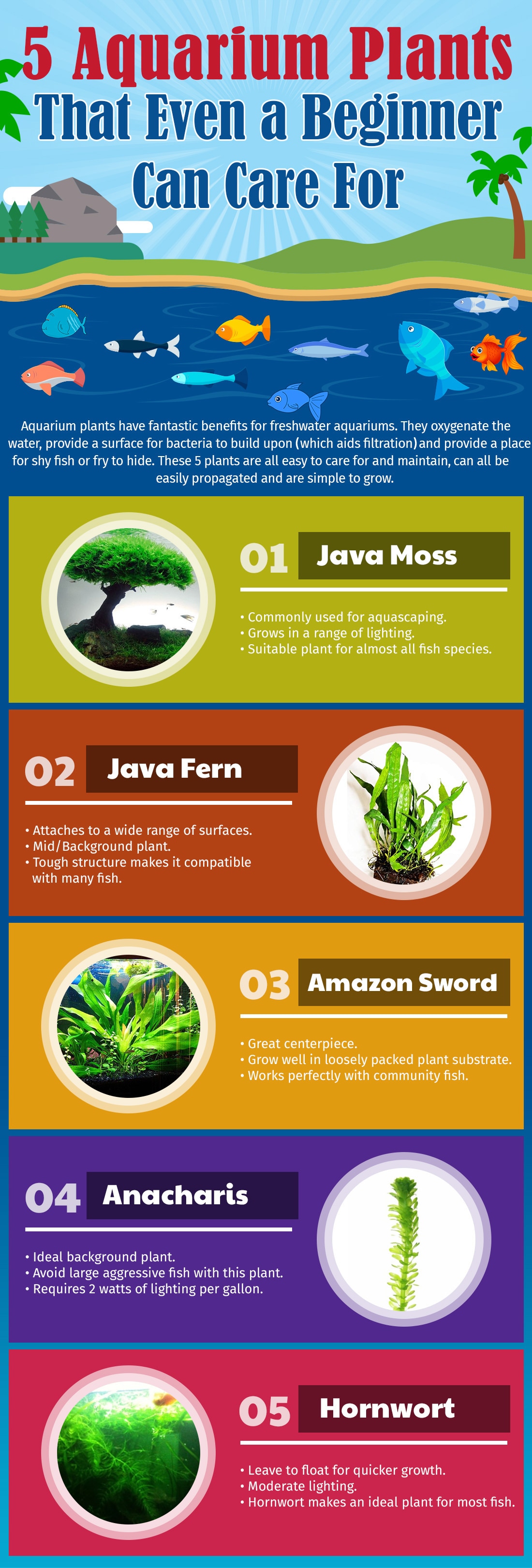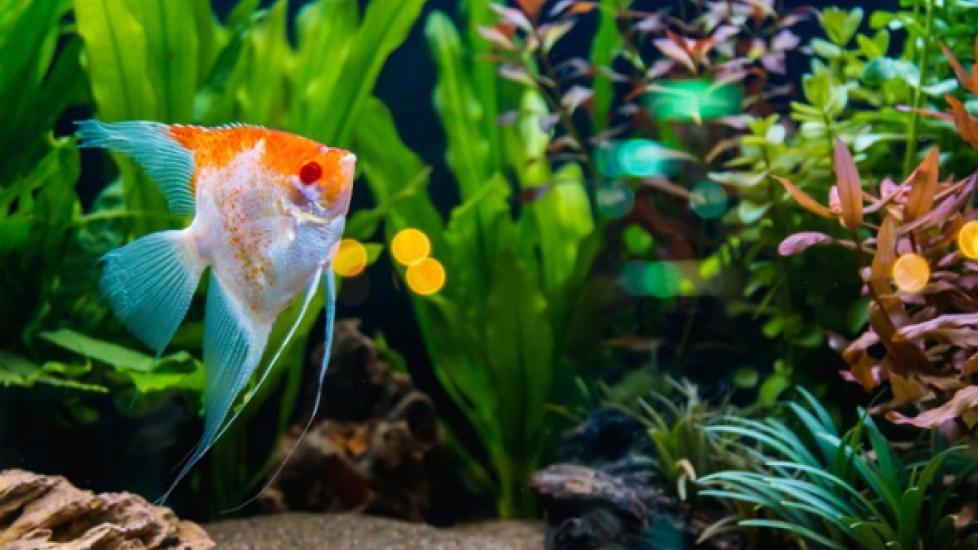5 Live Aquarium Plants That Even a Beginner Can Care For
Image via iStock.com/rookiephoto19
By Robert Woods of Fishkeepingworld.com
If you are thinking of keeping freshwater fish, the likelihood is that you will also have considered keeping live aquarium plants, too.
Some people choose artificial plants over living aquarium plants because they think live plants will be too difficult to look after.
Don’t let that put you off. Plants not only look great in a fish aquarium, but they provide a whole host of other amazing benefits. They act as great filtration, provide the water with oxygen, absorb carbon dioxide created by tank inhabitants, combat algae growth and provide shelter for your fish to hide in.
Here are five of the best beginner freshwater aquarium plants that are easy to care for and will add more color and life to your fish aquarium.
Java Moss
This is the first plant listed because it’s almost impossible to kill. Java moss is easy to grow and maintain and will attached to a wide range of surfaces, including gravel, rocks, driftwood and decorations.
Java moss can be used to cover the floor of an aquarium, create beautiful growths on rocks, create tree-like sculptures and provide the tank with a more natural feel.
It is commonly used for aquascaping and is also a great plant to include in breeder tanks, as it gives shelter to the eggs and fry.
Java moss grows in most water conditions. It thrives in temperatures between 69 and 75 degrees Fahrenheit and will tolerate temperatures up to 86 degrees Fahrenheit.
It will grow in low and high light; however, you’ll find that lower light creates a darker, lankier plant, and high light creates a more compact, dense plant.
Java moss is one of the rare plants that is compatible with pretty much all species of fish.
Java Fern
This is another popular live aquarium plant that is suited to beginners because of its unique shape and ease of care and reproduction.
There are a few variants available, such as narrow leaf, needle leaf and trident leaf. They’re all pretty easy to keep; it just depends on which look you prefer.
In its natural habitat, Java fern is found alongside streams and other slow-moving waters. Most filters provide enough flow to replicate this.
They thrive in water that’s between 68 and 82 degrees Fahrenheit, with a pH between 6.0 and 7.0 and a hardness of 3 to 8 dGH.
Java fern will grow in most lighting, but prefers a more subdued florescent light, such as the Aqueon Floramax plant growth bulb for T8 lamp. If the light is too strong, you’ll notice that the plant will become brown. An ideal range for your fish tank lighting is 1.5 to 2 watts of light per gallon in your tank.
The rhizomes on this plant do not like being buried. Instead you should attach this plant to rocks or driftwood, like the SubstrateSource cholla wood aquarium driftwood. Using either thread or specific aquarium glue, the rhizomes should attach themselves within a few weeks. Alternatively you can leave this aquarium plant to float.
The surfaces that you attach the plant to can be placed in the mid to background of the tank.
Once this plant is established in your aquarium, it is compatible with plenty of fish—it’s very difficult to tear apart, so even herbivorous fish can be housed with it. Most fish tend to stay away from it, though, because it has such a tough structure.
Amazon Sword
The Amazon Sword plant is a great background plant. It can also be used as a centerpiece because of its full green leaves, which create a forest-type look.
Caring for Amazon Sword plants is not difficult—they are easy to plant and maintain, and they grow quickly.
This live aquarium plant will thrive in a tropical tank with a heater (like the Aqueon preset aquarium heater) to maintain the water temperature between 72 and 82 degrees Fahrenheit, with a pH between 6.5 and 7.5.
It needs a moderate to strong light, which should be left on for 10 to 12 hours per day. These aquarium plants can grow quite quickly and may require regular trimming.
An aquarium plant’s substrate depends on the type of plant you choose. Amazon Sword plants do well in most substrates, including gravel, but thrive in loosely packed plant substrate, such as the CaribSea Eco-Complete planted aquarium substrate.
This plant can be housed with most community fish such as danios, tetras and guppies. Avoid housing it with Oscars, Texas cichlids or any other aggressive and rough species, which are likely to attack the plant.
Anacharis
This is another low-maintenance, easy-to-care-for aquarium plant. Commonly known in stores as Egeria or Elodea, is has dark green leaves, which provides aquariums with a really full, lush feel.
Anacharis can adapt to a wide range of water conditions but will thrive in a tropical tank in between 72 and 78 degrees Fahrenheit. Keep the pH between 6.5 and 7.5, and the hardness between 3 and 8 dKH.
Light for aquarium plants is a must and Anacharis is no different. Provide around 2 watts of lighting per gallon; this plant will grow well in moderate lighting. If the lighting is too low, they will probably die, whereas if the lighting is too high, it encourages green algae hair to grow on the Anacharis.
You can plant Anacharis directly into the substrate or leave it to float. If you choose to plant them, leave a gap of 1 to 2 inches between each plant so they’re not competing for nutrients.
Anacharis is usually used as a background aquarium plant and is commonly placed along the back wall of an aquarium.
This plant can be kept with small, peaceful community fish such as guppies and makes a great home for bettas, too. Don’t use this plant with large, more aggressive fish—it will uproot too easily.
Hornwort
Hornwort is one of the easiest live aquarium plants to grow. It grows so well in the wild that it has managed to spread to every continent except Antarctica.
It is a mid to background plant that is highly tolerable of a wide range of water conditions. It grows fast and is easy to propagate.
This aquarium plant requires a minimum tank size of 15 gallons; it grows quickly and will take over anything smaller than this.
It can survive in temperatures of 59 to 86 degrees Fahrenheit, and needs a pH in between 6.0 and 7.6 and a water hardness between 5 and 15 dGH.
Hornwort requires moderate to high lighting and clear water to allow the light to penetrate all the way through the tank.
This plant can either be anchored in the substrate or left to float. This is usually determined by the type of fish you keep with it (it does grow much faster if it’s left to float).
For example, surface-dwelling fish such as Hatchetfish would benefit from floating Hornwort, whereas tetras and other mid to lower level fish would enjoy Hornwort more if it were planted.
Hornwort makes an ideal plant for most fish. Livebearers will benefit the most from this plant as it provides somewhere to protect their young.
Some fish such as Gouramis and Angelfish enjoy eating this plant; others enjoy eating the debris that has shed from the Hornwort such as snails and shrimps.
So, Which Aquarium Plant is Best for You?
If you’re new to fish keeping and are looking for a great plant—any of these five aquarium plants will be great for your tank.
Take into consideration the fish you are hoping to keep. If you want to keep larger, more aggressive fish stick with the hardy java moss and java fern.
If you’re looking for something that can be used as more of a centerpiece, you might want to consider the Amazon Sword.

